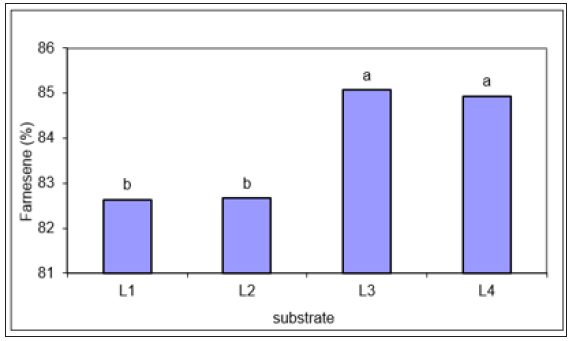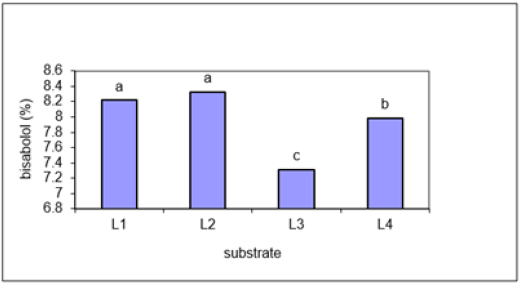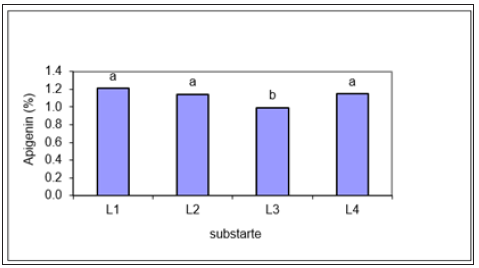- Submissions

Full Text
Environmental Analysis & Ecology Studies
The Effect of Hydroponic Mediums on Volatile Constituents and Secondary Metabolites of German Chamomile in Hydroponics System
Mehrdad Dalvand1* and Maryam Ramezani2/p>
1Doctor of Hydroponic Agriculture, Iran
2PhD Student of Biotechnology, Lorestan University, Iran
*Corresponding author: Mehrdad Dalvand, Doctor of Hydroponic Agriculture, Iran
Submission: December 13, 2020Published: June 01, 2021

ISSN 2578-0336 Volume8 Issue4
Abstract
“Matricaria Chamomilla L” has noticeable medicinal value among several species of chamomile. The volatile oil of chamomile flowers contains chemical Constituents such as Sesquiterpen and polyethylene which are obtained either by solvent extraction or steam distillation. Among all constituents of volatile oil, three constituents of chamomile are thought to be the most important compounds because they have anti-inflammatory properties these constituents include alpha-Bisabolol, chamazulen and Pharnesene. Volatile oils containing high amounts of chamazulene and α-biasabolol are called “Well-qualified volatile oils”. Cultivating in hydroponic culture is used as the best vegetable production technology not only for societies in order to prepare healthy products, but also for societies being faced with shortage of land, labor, and resources. In this study we have examined the effects of four different types of hydroponic Medium on quantity and quality of active ingredients of the plants. They are as follows: sand+perlite, cocopeat+sand+perlite, cocopeat+perlite, cocopeat. Also, we have examined volatile chemical compounds of chamomile flowers by using UA-HS-SPME-GC/MC method. We had used PDMS fiber to extract the compounds in HS-SPME method. Optimal conditions developed by Professor Ghyasvand and colleagues was used to analysis the samples and consequently as the results represent, type of culture has a main role in quantity and quality of active ingredients of chamomile.
Keywords: Chamomile; Active ingredients; Hydroponics Mediums
Introduction
Chamomile is one of the oldest medicinal herbals recognized by human. “Matricaria chamomilla L” belongs to composiate family and “radiae” subfamily, but there are plenty of other species which are called chamomile. Among all of them, “Matricaria Chamomilla L” has an important medicinal value. Medicinal herbals Cultivation increasingly is became important and is one of the most important branches of agriculture studies which is applicable in extracting and producing ingredients in order to produce drugs [1]. The volatile oil of chamomile flowers contains chemical Constituents such as sesquiterpenes and polyethylene which are obtained either by solvent extraction or steam distillation. Among chamomile volatile oil compounds, chamazulen, bisabolol, Pharnesene and its oxides are recognized as the most important compounds because of their anti-inflammatory properties [2,3]. Essential oils which contain high amount of bisabolol and chamazulene are recognized as well-qualified ones.
Cultivating in hydroponic culture is used as the best vegetable production technology not only for societies in order to prepare healthy products, but also for societies being faced with shortage of land, labor, and resources. Now days in 2012, organic and inorganic materials are used as culture in hydroponic system. Each of these materials includes unique properties. In general, materials which are used as culture or root protection in hydroponic planting must have high capacity to accumulate water and food, adequate ventilation, proper drainage and also exchange Capacity of Cationic (CEC). They must not have adverse impact on plant [4]. Due to mentioned statements and importance of medicinal herbals, we have studied herbal chamomile and its active ingredients in four different hydroponic cultures: sand+perlite, cocopeat+ perlite, cocopeat+perlite+sand, cocopeat.
We hope this study to be useful for research institutes and farmers.
Materials and Methods
This study was carried out in “Negin sabz Greenhouse” located in the village of khorramabad city in February 2009. In this study we have used modified German chamomile seed. Due to the desired scheme of planting beds, flower pots were filled in equal ratios and were settled next to each other. Cultures which were examined in this study are: sand+perlite, cocopeat+perlite, cocopeat+perlite+ sand, cocopeat. Cultivated chamomile samples grown in greenhouse, were collected after completing their growth, to extract and to recognize volatile compounds, under hydroponic circumstances. Various plant organs, including leaves, flowers and stems were dried in the dark and ambient temperature. Then crushed and powdered by millhouse and roughness powder were kept in capped containers and in laboratory circumstances till coming analysis time. UA-HS-SPME method was used to extract volatile compounds and in this method we have used PDMS fiber. Here optimal conditions developed by Dr. Ghyasvand and colleagues were used [5].
Table 1:

Conditions for isolating and detecting chamomile volatile compounds were initial column temperature was 40 °C per minute then it was increased to 180 °C per minute and was kept at this temperature for one minute after that this temperature reached to 250 °C at the rate of 10 °C and remain constant until all ingredients safely be removed from the column and column is prepared for the next analysis. During isolation, injection temperature was 250 °C. Flowing rate of inside carrier gas was 0/9mm/minute. Injection system was adjusted undividedly. applied conditions for mass detector were: temperature of ionization chamber was 250 °C, ionization energy was 70 electron volt, scrolling speed was 1000 scans per second and mass region varied between 35 to 400 by examining obtained chromatogram and ensuring about successful method for separation of peaks, designed program was defined as optimized temperature program and as so the procedure to measuring the volatile compounds of 16 samples of chamomile was performed by using this program [6] (Table 1).
After qualitative identification of volatile compounds extracted from chamomiles cultivated under hydroponic circumstances by mass spectra and company them with standard spectra available in the library (NIST) and settled on GC/MS device, the RI of compounds were calculated based on Linear Temperature Programmed Retention Index (LTPRI) and using a mixture of c8-c10 linear Alkenes for more accurate identification and quantification of compounds [7,8]. All the experimental procedures were done in laboratories of department of chemistry of Lorestan and medicine university of Lorestan (Figures 1-7).
Figure 1: Effect of substrate on the Farnesene.

Figure 2: The effect of substrate on the Chamazulene.

Figure 3: The effect of substrate on the Bisabolol.

Figure 4: The effect of substrate on the Germacrene.

Figure 5:The effect of substrate on the Apigenin.

Figure 6: The effect of substrate on the Patuletin.

Figure 7:The effect of substrate on the Quercetin.

we have concluded that: A culture effect on fresh weight of pharmaceutical raw materials of chamomile is significant on level 1%. Most fresh weight of pharmaceutical raw materials is gained in L2 culture which had represented no significant difference with L4 culture (234g). Lowest fresh weight of pharmaceutical raw materials was obtained in L3 culture (226kg) which had significant difference with L1 culture (230.1g). The effect of hydroponic mediums on weight of medicinal raw materials of chamomile was significant on level 1%.most dry weight of medicinal raw materials was obtained in L2 culture (101g) which had significant difference with L4 culture (98.5g). Lowest dry weight of medicinal raw materials was gained in L3 culture (95g) and represented significant difference with L1 culture. The effect of hydroponic mediums on Pharenesene percentage in chamomile was significant on level 1%. Most Pharenesene percentage was obtained in L3 culture (85%) which has represented no significant difference with L4 culture (84.8%) lowest Pharnesene percentage was obtained in L3 and L2 culture (82.5%) (Table 2).
Table 2:

Plan
A. Bed planting
1. 1-L1 (cocopit) 2- L2 (sand+perlit) 3- L3 (cocopit+perlit) 4- L4 (cocopit+sand+perlit)
B. Food solution
2. 1-F1(Hogland) 2-F2 (Eshnider) 3- F3 (Cooper) 4- F4 (My solution)
C. Replication
3. 1-R1 2- R2 3- R3 4- R4
Result
By examining four hydroponics cultures and their different effects based on various isolation tables calculated in this study
The effect of hydroponic mediums on chamazulen percentage in chamomile was significant on level 1%. Most available chamazulen was obtained in L2 culture (3.28%) which has shown no significant difference with L1 and L4. lowest percentage of chamazulen was obtained in L3 culture (3.0%). The effect of hydroponic mediums on available bisabolol percentage in chamomile was significant on level 1%. Most percentage of bisabolol was obtained in L2 culture (8.4%) which has represented no significant difference with L1 culture (8.2%) and lowest percentage of bisabolol was obtained in L3 culture (7.2%) which had significant difference with L4 culture (7.88%). The effect of hydroponic mediums on jermakerin percentage in chamomile was obtained on level 1 %. Most percentage of Jermakerin was obtained in L3 culture (3.18%) which had no significant difference with L4 culture (3.15%). Lowest percentage of Jermakerin was obtained in L1 culture (3.00%) which had significant difference with L2 culture (3.08%). The effect of hydroponic mediums on weight of essential oil was significant on level 1%. Most percentage of weight of essential oil was obtained in L2 culture (1.38mg) which has represented no significant difference with L1 culture (1.37mg) and lowest percentage of weight of essential oil was obtained in L4 culture (1.32mg) which had significant difference with L3 culture (1.36mg) (Table 3).
Table 3: Table of the elements in the nutrient solution used by the researcher.

The effect of hydroponic mediums on efficiency of essential oil was significant on level 1%. Most percentage of efficiency of essential oil was obtained in L2 culture (1.65mg) which has represented no significant difference with L3 culture (1.6mg) and lowest percentage of efficiency of essential oil was obtained in L4 culture (1.35mg) which had significant difference with L1 culture (1.43mg) [9,10]. The effect of hydroponic mediums on weight of extract was significant on level 1%. Most percentage of weight of volatile oil was obtained in L3 culture (37.2mg) which has represented no significant difference with L1 culture (35.2mg) and lowest percentage of weight of essential oil was obtained in L2 culture (34.8mg) which had significant difference with L4 culture (35mg).
The effect of hydroponic mediums on efficiency of extract was significant on level 1%. Most percentage of efficiency of volatile oil was obtained in L2 culture (223mg) which has represented no significant difference with L1 and L4 culture and lowest percentage of efficiency of essential oil was obtained in L3 culture (212mg). The effect of hydroponic mediums on Apigenin percentage in chamomile was significant on level 1%. Most percentage of Apigenin was obtained in L1 culture (1.2%) which has represented no significant difference with L2 and L4 culture and lowest percentage of Apigenin was obtained in L3 culture (1.0%). The effect of hydroponic mediums on Patoletin percentage in chamomile was significant on level 1%. Most percentage of Patoletin was obtained in L1 culture (44.1%) which has represented no significant difference with L4 culture (43.8%) and lowest percentage of Patoletin of was obtained in L3 culture (38%) which had no significant difference with L2 culture (39.2%). The Effect of Hydroponic Mediums on Quercetine percentage in chamomile was significant on level 1%. Most percentage of Quercetine was obtained in L3 culture (0.580%) which has represented significant difference with L1 culture (0.545%) and lowest percentage of Quercetine of was obtained in L2 culture (0/520%) which had no significant difference with L4 culture (0.532%).
So due to this study type of culture plays main role in quantity and quality of active ingredients of chamomile. This study is the first research in the field of measuring qualitative properties and minor metabolites of chamomile under hydroponics circumstances thus comparing directly the results with results from other researchers is not probable. This study can be as basic reference for other researchers for cultivation and extraction of secondary metabolites of chamomile and similar plants (Table 4).
Table 4: Means comparison of hydroponic volume and nutrition solution on matricaria chamomile.

References
- Mehravaran H (2014) Technology and Entrepreneurship in hydroponics.
- Rahmati M, Azizi M, Nemati M (2016) Effect of different levels of density, and nitrogen on morphological traits, amount of Chamomile essential oil and the percentage chamazulen, Horticultural Sciences (Agricultural Science and Technology). (23rd edn), pp. 27-35.
- Sanavi M, Modares A, Malbobi Y (2011) Effect of different levels of phosphorus fertilizer in combination with bio fertilizer phosphate fertilizer on efficiency and essential oil and chamazulen percentage of German chamomile. Quarterly Journal of Medicinal and Aromatic Plants in Iran. (27th edn), pp. 450-459.
- Erik B, Michael W (2004) Medicinal plants of the world. Briza South Africa p. 480.
- Ghiasvand AR, Nasseri M, Farsizaeh S, Sadeghi R, Shadabi S, et al. (2011) Chromatographia 73: 1031.
- Omid R Beigi (2018) Principles of producing and possessing of medicinal herbals, (2nd edn),
- Marandi RJ (2004) Postharvest Physiology, Fruit handling and maintenance, ornamental vegetables and herbals compilation.
- Velag J, Stodla J (2008) Plantes Medicines. Translat by Zaman S, Qoqnoos.
- Morard P (2009) Above ground vegetable crops. In: Roustaee A (Ed.), University of Tehran, Iran.
- Resh HM (2010) Hydroponic food production. In: Jafarnia S, Khosroshahi A, Sabziran (Eds.).
© 2021 Mehrdad Dalvand. This is an open access article distributed under the terms of the Creative Commons Attribution License , which permits unrestricted use, distribution, and build upon your work non-commercially.
 a Creative Commons Attribution 4.0 International License. Based on a work at www.crimsonpublishers.com.
Best viewed in
a Creative Commons Attribution 4.0 International License. Based on a work at www.crimsonpublishers.com.
Best viewed in 







.jpg)






























 Editorial Board Registrations
Editorial Board Registrations Submit your Article
Submit your Article Refer a Friend
Refer a Friend Advertise With Us
Advertise With Us
.jpg)






.jpg)














.bmp)
.jpg)
.png)
.jpg)










.jpg)






.png)

.png)



.png)






